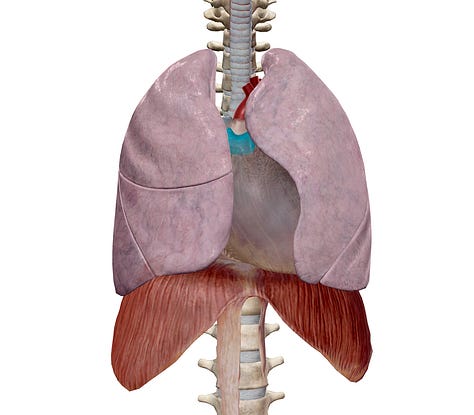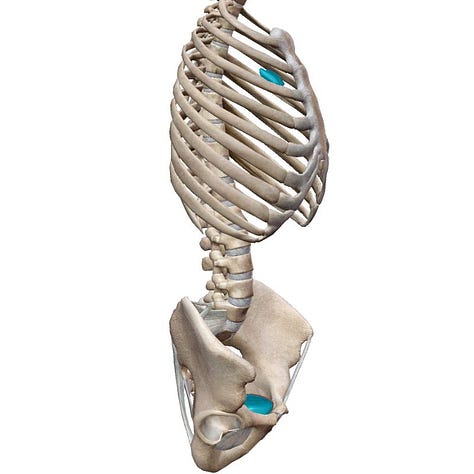THYMUS: the school of me and not-me
A primary organ of our immune system, the thymus is a place where we can embody discernment, energise our sense of purpose, and resource personal boundaries.
The word thymus comes from the Greek thýmos (θύμος), conveying the idea of spiritedness, not in the sense of something etheric, but more the rush and vigour of a horse at gallop. It holds a sense of heat and breath, vitality, motivation and agency.
We have an organ called the thymus that resides just above our heart where immune cells travel from our bone marrow to mature. It’s where they begin to learn how to recognise what is me and what is not-me. Once they graduate, they head out into the body to further specialise and whenever they detect something that is not-me, like a harmful bacteria or virus, they rally into action.
FORM AND FUNCTION
The thymus is a butterfly-shaped organ being made up of two connected lobes. It’s located in the rib cage behind the breastbone just above your heart, so around rib 2/3. In our adult body, it’s about the size of an apricot, weighing between 5-15g. At birth, it’s a similar size yet, relative to our infant body, it is of course quite large. The thymus in fact continues to grow throughout our childhood and adolescence until it gets to roughly the size of a lemon, weighing between 30-50g. This happens as a result of accumulating more and more knowledge of immunity. Once into full adulthood, it goes through a process called involution, essentially shrinking in size until in advanced old age, it can be next to invisible in the eyes of a dissecting anatomist.
The function of the thymus is to provide a location within our overall immune system for the maturation of a specific type of immune cell called T-lymphocytes, or T-cells. These are crucial for our acquired immune response system. This is the one that actively learns to recognise and respond to antigens and pathogens, that is to say, substances that are not-me and potentially detrimental to my health.
Once T-cells are primed and ready they graduate from the thymus and enter the blood stream where they begin their surveillance role. They take up residence in lymph nodes, the spleen, and in various lymphoid tissues distributed around the body. They are waiting to be “activated” by the presence of harmful molecules or agents of infection. When this happens, the “naive” T-cell becomes a specialist in the recognition of a partiuclar substance and thereafter becomes an “effector” T-cell. Now it knows to which sites of infection or inflamation to travel to, when to travel to them, and what its role in the immune response will be.
Phew! that was a lot of information, so now let’s see if we can now actually find the thymus in our own body.
LOCATION & ORIENTATION
I’ve included some images below that I created in the Humany Anatomy Atlas from Visible Body to help you locate the thymus as you go through the following steps.
Find the dip at the base of your throat which is the top of your sternum (breastbone) and walk your fingers away from the centre to find the first rib which is under your collar bone
Walk your fingertips down a little bit and you land on the soft gap before finding the hard bone of your second rib. Repeat, and you’ll finally the third rib.
Now, walk you fingertips back to the sternum itself, and you are now just in front of your thymus.
I quite like to lightly tap the bone a few times as if I am knocking on the stable door to let the thymus know I am here.
Focus for a few moments and try to get beyond the big presence of your heart beat. Try imagining your thymus lighting up with your attention. Remember, depending on your age, it’s about the size of an apricot and shaped a bit like a butterfly.



SUPPORT FOR POSTURE AND MOVEMENT
The central location of the thymus in the thorax lends itself as an anchor of support for the “yield and push” patterns of the upper limbs, since we can trace lymph vessels from the thymus towards the nodes in the armpits and then further, to take us out to the hand. The energy of lymph is purposeful and direct so the yield and push has the potential to be very clear and decisive. This could be really useful to access in movements that require arm support and, for example, in ‘jumping’ forms of Sun Salutations.
The thymus also provides indirect support for the thoracic spine by providing an upward and forward direction to the organisation of the sternum and ribs. And, in back bending/arching, it can be a site of anchorage for the extension of the neck and weight of the head - think connecting heart to thymus to thyroid to pituitary.
On a final note, I would suggest exploring connections the thymus could make in the lower body that offer a balancing dynamc between the containers of the rib cage and the pelvis. For me, I find there is a relationship between the somewhat dense organ of the thymus and the hollow, tidal organ of the bladder. Both connect via the Deep Front Line fascial train (ref Tom Myers’ work) and I’ll expand on this in the Companion Notes.



SOMATIC ASSOCIATIONS
Looking at the location of the thymus and its function, it’s easy to understand how it is sometimes referred to as the “heart of the immune system”. Somatically, its discerning nature can offer relational support to matters of the heart and to the setting of personal boundaries. It could be useful to remember that the thymus is a place of cellular learning which suggests to me that our boundary setting is also learned, and sometimes we get it right, and sometimes we get it wrong.
Finally, circling back to the etymology, if you feel a lack of energy, lost your vip and vim, then spend some time considering how your “spiritedness” may be being depeleted. Conjour up your horse-energy (or your sassy inner-child, or feisty inner-teenager) and think about people, places and situtations where you could safely strengthen boundaries and exercise your will.
Thanks as ever for reading or listening. In Companion Notes, we’ll dip a bit more into fascial connections, a tad of embryology, do some practice, and explore some journaling prompts. Plus a few thoughts to share with on autoimmune responses - when T-cells are mistaken.
warm wishes from me,
Beverley





